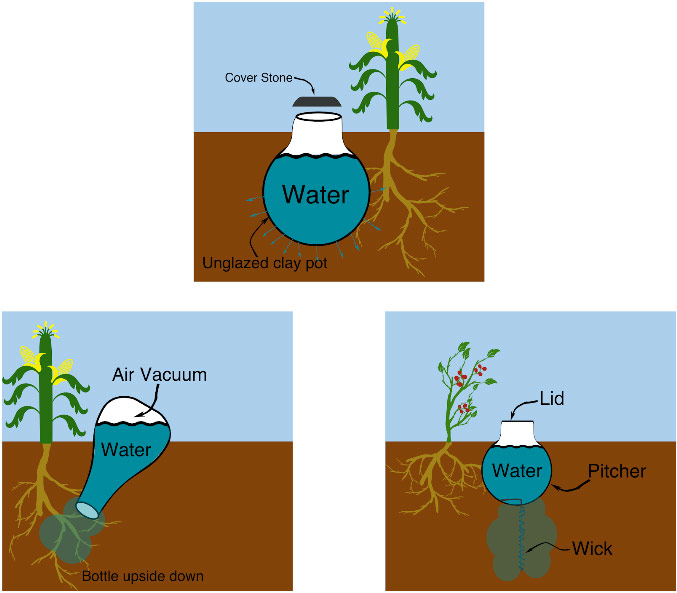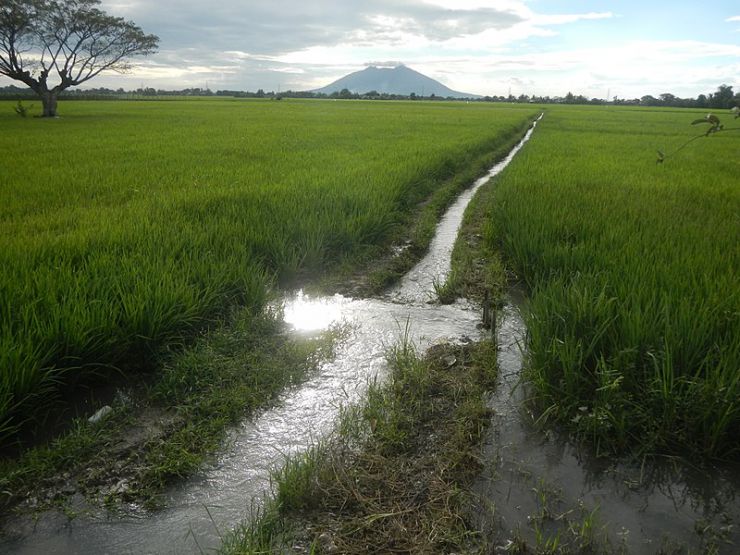Background:
Water scarcity is a major global challenge, particularly in arid and semi-arid climates, with half a billion people facing severe water scarcity year round.1 Climate change is expected to increase pressure on this finite resource. Water scarcity can occur due to lack of available freshwater resources, lack of access to water services, and lack of appropriate infrastructure to capture and convey water to users. Food production requires a significant amount of water, accounting for 85% of freshwater withdrawals globally.2,3 Over the last 40 years, irrigated land for agriculture has increased by 70% resulting in lowered groundwater tables, degraded groundwater quality, and decreased reliability of groundwater to act as a buffer during times of drought.4 Unsustainable use of freshwater for agriculture has led to an increase in the risk of food insecurity. Drought frequency and severity, especially in arid and semi-arid locations, is increasing due to climate change, and water will need to be carefully managed before, during and after drought to mitigate its negative impacts and to secure healthy livelihoods. A healthy soil, where organic matter is actively managed, can help combat the effects of water scarcity by increasing the water holding capacity of a soil.
Diagnosing:
Water scarcity occurs in locations where water supply is lower than crop demands causing plants to wilt. In very water scarce regions soil structure will also be affected and cracking may develop. The wilting point and field capacity of a soil can be helpful information for informing water management decisions to strike a balance between water savings and sufficient yields.
Picture of drought (royalty free): https://www.maxpixel.net/Drought-Dry-Climate-Change-Environment-Climate-2241061

Management:
Below is a short summary of various management practices. For a full list of additional resources click here.
Agricultural Management
Many soil management practices can be implemented to reduce water stress by improving the overall health of the soil. These practices include
- Improving soil structure by reducing or eliminating tillage to allow for better infiltration of water
- Building organic matter to increase water retention
- Reducing evaporation by putting mulch or straw on the soil surface
Irrigation Management
Properly managed irrigation to reduce crop stress and maximize yield is important, especially during times of drought. The following practices can help improve irrigation management
- Constructing dams to help store water for irrigation throughout the growing season
- An understanding of the water balance, including the determination of a soil’s field capacity, wilting point, available water capacity, and the water requirements of the crop should be executed to maintain favorable yields.
- Efficient irrigation strategies including drip irrigation systems, buried clay pot systems, capture and reuse of irrigation water in gravity based methods of irrigation (flood or furrow irrigation)
Water Harvesting and Storage
The following practices can be implemented to capture and store water during times of excess precipitation to be able to persist through dry seasons.
- Runoff can be harvested from roofs or ground surfaces. Creating small storage technologies is an option when cost is an issue
- Collection of floodwater from waterways
- By reducing runoff and erosion, water can be stored in the soil (soil moisture storage) or, if not immediately used by plants, in groundwater
- Retaining structures can be devised so that water infiltration into the soil can be controlled to reduce runoff and erosion
- Health and safety are a concern when it comes to water storage and handling and the risks must be communicated. Both surface and groundwater can be contaminated and unsafe for irrigation of crops and for drinking or household uses. Rainwater can carry pollutants and fecal matter with it when running off surfaces such as roofs. Usually the first flush of water carries the highest concentration of pollutants and should be avoided for collection. If possible, water should be tested and treated before use.
Drought tolerant crops
Planting crops that are more resistant to drought, such as millet or sorghum, can help improve yields in water limited areas.

Low cost methods for efficient irrigation. Adapted from Woldu, Zenebe. 2015. Clay Pot Pitcher Irrigation: A Sustainable and Socially Inclusive Option for Homestead Fruit Production under Dryland Environments in Ethiopia (A Partial Review). Journal of Biology, Agriculture and Healthcare.
Additional Resources:
Water Harvesting and Storage
- FAO website on harvesting and storing water http://www.fao.org/land-water/water/water-management/water-storage/en/
- A company, RainSaucer Inc, blog on building a cost effective tank for rainwater collection http://rainsaucers.com/blog/2014/02/19/the-two-dollar-tank-a-new-method-for-rainwater-harvesting-in-developing-countries
- United Nations University article on health concerns with rainwater collection https://unu.edu/publications/articles/rainwater-and-health-in-developing-countries-a-case-study-on-uganda.html
- A blog from Massachusetts Institute of Technology on safe rainwater collection http://news.mit.edu/2012/itw-rainwater-harvesting-0305
Irrigation Management
- FAO document describing field capacity and wilting point http://www.fao.org/docrep/r4082e/r4082e03.htm#2.4%20available%20water%20content
- Subsoils manual on crop water requirements https://soilhealth.ucdavis.edu/download_file/view/244/235
- YouTube video by FAO on constructing irrigation dams in Uganda https://www.youtube.com/watch?v=JkP-qsQdp3w
- FAO document on water requirements for crops and overall water balance http://www.fao.org/docrep/T0231E/t0231e05.htm#3.2%20determining%20water%20requirements
- Worldwatch Institute newsletter on low cost irrigation systems including buried clay pot irrigation systems http://blogs.worldwatch.org/nourishingtheplanet/beyond-drip-irrigation-to-water-fields-in-dry-land-areas-an-interview-with-david-bainbridge/
- Journal of Biology, Agriculture, and Healthcare open access article written by Zenebe Woldu on clay pot pitcher irrigation in Ethiopia https://soilhealth.ucdavis.edu/download_file/view/245/235
- NRCS Article on affordable drip irrigation technologies for developing countries by Jack Keller and Andrew A. Keller https://soilhealth.ucdavis.edu/download_file/view/246/235
- Engineering for change blog on low-cost irrigation techniques https://www.engineeringforchange.org/news/ten-low-tech-ways-to-irrigate-crops/
- FAO article on managing discharge of irrigation water to match infiltration rate http://www.fao.org/docrep/T0231E/t0231e04.htm#2.3%20requirements%20for%20optimal%20performance
- FAO manual on surface irrigation management http://www.fao.org/docrep/T0231E/t0231e00.htm#Contents
Irrigation canal in Bangladesh (royalty free) https://commons.wikimedia.org/wiki/File:03515jfPaddy_fields_grasslands,_trees_and_irrigation_Pulo_Tabon_San_Isidro_Nueva_Ecija_Roadfvf_23.jpg
Agricultural Management
- FAO article on water conservation through methods such as bed formations http://www.fao.org/docrep/T0321E/t0321e-11.htm#P1259_112543
- FAO manual on general soil conservation management including topics such as soil amendments for water conservation https://soilhealth.ucdavis.edu/download_file/view/247/235
Drought-Resistant Crops
- UC ANR table on drought-resistant crops https://soilhealth.ucdavis.edu/download_file/view/248/235
- Newsletter from ICRISAT on drought-resistant crops in Kenya https://www.icrisat.org/drought-tolerant-crops-to-the-rescue-in-kenya/
Further Information
- FAO document on drought resistant soils, describes ways of keeping moisture in the soil http://www.fao.org/docrep/009/a0072e/a0072e07.htm
- World Resources Institute website for mapping and understanding water risk around the globe https://www.wri.org/our-work/project/aqueduct
- FAO downloadable book discussing comprehensive management of water in agriculture including trends in water in agriculture and management practices to alleviate consequences of water scarcity https://soilhealth.ucdavis.edu/download_file/view/249/235
- FAO website on all things water http://www.fao.org/land-water/water/water-management/agriculture-water-management/en/
- FAO handbook on soil and water conservation http://www.fao.org/docrep/T0321E/T0321E00.htm
References:
- Mekonnen, M.M., & Hoekstra, A.Y. (2016). Four billion people facing severe water scarcity. Science Advances, 2 (2). Doi:10.1126/sciadv.1500323
- J.S Wallace, Increasing agricultural water use efficiency to meet future food production, Agriculture, Ecosystems & Environment, V
- Foley, J.A., DeFries, R., Asner, G.P., Barford, C., Bonan, G., Carpenter, S.R., Chapin, F.S., Coe, M.T., Daily, G.C., Gibbs, H.K., Helkowski, J.H., Holloway, T., Howard, E.A., Kucharik, C.J., Monfreda, C., Patz, J.A., Prentice, I.C., Ramankutty, N., Snyder, P.K., 2005. Global Consequences of Land Use. Science (80-. ). 309, 570 LP-574.
- Siebert, S., Burke, J., Faures, J., Frenken, K., Hoogeveen, J., Döll, P. and Portmann, F. (2010). Groundwater use for irrigation – a global inventory. Hydrology and Earth System Sciences, 14(10), pp.1863-1880.

